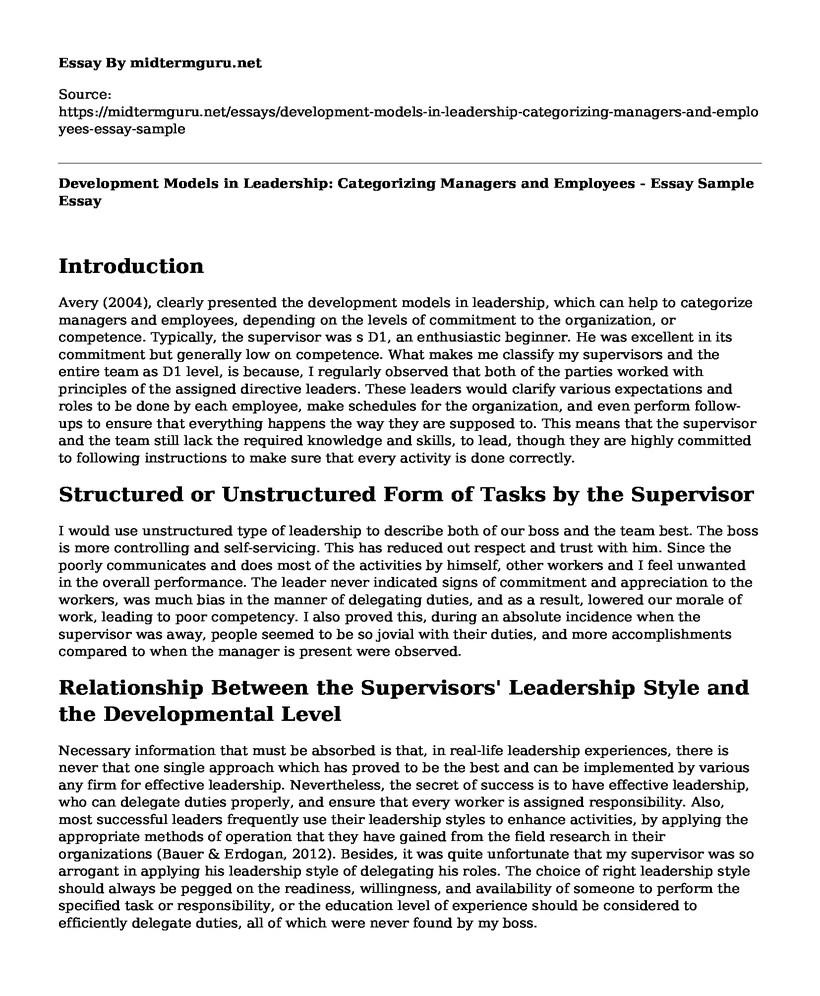Introduction
Avery (2004), clearly presented the development models in leadership, which can help to categorize managers and employees, depending on the levels of commitment to the organization, or competence. Typically, the supervisor was s D1, an enthusiastic beginner. He was excellent in its commitment but generally low on competence. What makes me classify my supervisors and the entire team as D1 level, is because, I regularly observed that both of the parties worked with principles of the assigned directive leaders. These leaders would clarify various expectations and roles to be done by each employee, make schedules for the organization, and even perform follow-ups to ensure that everything happens the way they are supposed to. This means that the supervisor and the team still lack the required knowledge and skills, to lead, though they are highly committed to following instructions to make sure that every activity is done correctly.
Structured or Unstructured Form of Tasks by the Supervisor
I would use unstructured type of leadership to describe both of our boss and the team best. The boss is more controlling and self-servicing. This has reduced out respect and trust with him. Since the poorly communicates and does most of the activities by himself, other workers and I feel unwanted in the overall performance. The leader never indicated signs of commitment and appreciation to the workers, was much bias in the manner of delegating duties, and as a result, lowered our morale of work, leading to poor competency. I also proved this, during an absolute incidence when the supervisor was away, people seemed to be so jovial with their duties, and more accomplishments compared to when the manager is present were observed.
Relationship Between the Supervisors' Leadership Style and the Developmental Level
Necessary information that must be absorbed is that, in real-life leadership experiences, there is never that one single approach which has proved to be the best and can be implemented by various any firm for effective leadership. Nevertheless, the secret of success is to have effective leadership, who can delegate duties properly, and ensure that every worker is assigned responsibility. Also, most successful leaders frequently use their leadership styles to enhance activities, by applying the appropriate methods of operation that they have gained from the field research in their organizations (Bauer & Erdogan, 2012). Besides, it was quite unfortunate that my supervisor was so arrogant in applying his leadership style of delegating his roles. The choice of right leadership style should always be pegged on the readiness, willingness, and availability of someone to perform the specified task or responsibility, or the education level of experience should be considered to efficiently delegate duties, all of which were never found by my boss.
Recommendations Based On Either Situational Leadership Model or Perth-Goal Model
Definitely, the answer would be yes. The notion that those individuals who have excellent performance of being supervisors must never be put together with the fact that they can generally make up excellent managers as well. This is when the argument is based on the Situational Leadership model or the Perth-Goal model. Situational Leadership model, as a doctrine in correlation with the leadership of business firms, helps in the promotion of the various managerial styles to ensure that more significant population benefits in an organization (Kadian-Baumeyer, 2013). This is a reverse of the ancient view, which stated that an executive manager would take care of all the duties in an organization without delegating them to the subordinates and other intermediaries in the setup. Our supervisor should thus employ the use of this model, to gain more profound knowledge and understand the benefits of delegating duties in a workplace.
References
Avery, G. (2004). Contingency theories: Situations matter. In Chapter 4 of Understanding leadership: Paradigms and cases. London: SAGE Publications Ltd. [Available in EBSCO eBook Collection.
Bauer, T., & Erdogan, B. (2012). Chapter 12.4: What is the role of the context? Contingency approaches to leadership. In Organizational Behavior. Saylor Academy.
Kadian-Baumeyer, K. (2013). Hersey-Blanchard's Model of Situational Leadership [Video file]. Education Portal. Retrieved from https://study.com/academy/lesson/hersey-Blanchard's-model-of-situational-leadership.html
Cite this page
Development Models in Leadership: Categorizing Managers and Employees - Essay Sample. (2023, Feb 05). Retrieved from https://midtermguru.com/essays/development-models-in-leadership-categorizing-managers-and-employees-essay-sample
If you are the original author of this essay and no longer wish to have it published on the midtermguru.com website, please click below to request its removal:
- Essay Example on Process of Bringing a Product or Service to Market
- Evaluation Paper Example on Uber Company
- Johns Hopkins Medicine Strategic Plan
- Essay Sample on Group and Team Behavior
- Research Paper on Mental Health Facilities
- Essay Sample on Applying an Ethical Decision-Making Model
- SDLC: Integrating Technology in Health Care for the Future - Essay Sample







